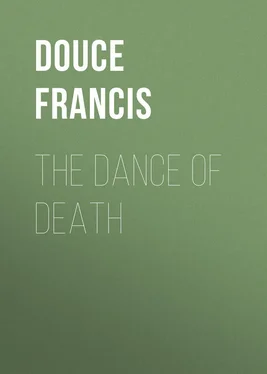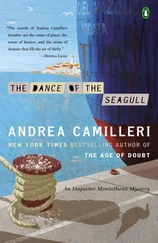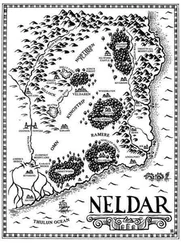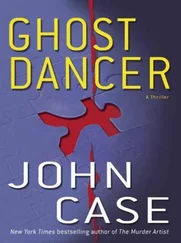Francis Douce - The Dance of Death
Здесь есть возможность читать онлайн «Francis Douce - The Dance of Death» — ознакомительный отрывок электронной книги совершенно бесплатно, а после прочтения отрывка купить полную версию. В некоторых случаях можно слушать аудио, скачать через торрент в формате fb2 и присутствует краткое содержание. Жанр: foreign_antique, foreign_prose, на английском языке. Описание произведения, (предисловие) а так же отзывы посетителей доступны на портале библиотеки ЛибКат.
- Название:The Dance of Death
- Автор:
- Жанр:
- Год:неизвестен
- ISBN:нет данных
- Рейтинг книги:5 / 5. Голосов: 1
-
Избранное:Добавить в избранное
- Отзывы:
-
Ваша оценка:
- 100
- 1
- 2
- 3
- 4
- 5
The Dance of Death: краткое содержание, описание и аннотация
Предлагаем к чтению аннотацию, описание, краткое содержание или предисловие (зависит от того, что написал сам автор книги «The Dance of Death»). Если вы не нашли необходимую информацию о книге — напишите в комментариях, мы постараемся отыскать её.
The Dance of Death — читать онлайн ознакомительный отрывок
Ниже представлен текст книги, разбитый по страницам. Система сохранения места последней прочитанной страницы, позволяет с удобством читать онлайн бесплатно книгу «The Dance of Death», без необходимости каждый раз заново искать на чём Вы остановились. Поставьте закладку, и сможете в любой момент перейти на страницу, на которой закончили чтение.
Интервал:
Закладка:
Of this Dance of Death very few specific copies have been made. M. Heinecken 58 58 Heinecken Dictionn. des Artistes, iii. 67, et iv. 595. He follows Keysler’s error respecting Hans Bock.
has stated that it was engraved in 1544, by Jobst Denneker of Augsburg; but he has confounded it with a work by this artist on the other Dance of Death ascribed to Holbein, and which will be duly noticed hereafter. The work which contained the earliest engravings of the Basle painting, can on this occasion be noticed only from a modern reprint of it under the following title: “Der Todten-Tantz wie derselbe in der weitberuhmten Stadt Basel als ein Spiegel menslicher beschaffenheit gantz kuntlich mit lebendigen farben gemahlet, nicht ohne nutzliche vernunderung zu schen ist. Basel, bey Joh. Conrad und Joh. Jacob von Mechel, 1769, 12mo.” that is, “The Dance of Death, painted most skilfully, and in lively colours, in the very famous town of Basel, as a mirror of human life, and not to be looked on without useful admiration.”
The first page has some pious verses on the painting in the church-yard of the Predicants, of which the present work contains only ten subjects, namely, the cardinal, the abbess, the young woman, the piper, the jew, the heathen man, the heathen woman, the cook, the painter, and the painter’s wife. On the abbess there is the mark D. R. probably that of the engraver, two cuts by whom are mentioned in Bartsch’s work. 59 59 Peintre graveur, ix. 398.
On the cut of the young woman there is the mark G S with the graving knife. They are coarsely executed, and with occasional variations of the figures in Merian’s plates. The rest of the cuts, thirty-two in number, chiefly belong to the set usually called Holbein’s. All the cuts in this miscellaneous volume have German verses at the top and bottom of each page with the subjects. If Jansen, who usually pillages some one else, can be trusted or understood, there was a prior edition of this book in 1606, with cuts having the last-mentioned mark, but which edition he calls the Dance of Death at Berne; 60 60 Essai sur l’Orig. de la Gravure, i. 120.
a title, considering the mixture of subjects, as faulty as that of the present book, of which, or of some part of it, there must have been a still earlier edition than the above-mentioned one of 1606, as on the last cut but one of this volume there is the date 1576, and the letters G S with the knife. It is most probable that this artist completed the series of the Basle Dance, and that some of the blocks having fallen into the hands of the above printers, they made up and published the present mixed copy. Jost Amman is said to have engraved 49 plates of the Dance of Death in 1587. These are probably from the Basle painting. 61 61 Heinecken Dictionn. des Artistes, i. 222.
The completest copies of this painting that are now perhaps extant, are to be found in a well-known set of engravings in copper, by Matthew Merian, the elder, the master of Hollar. There are great doubts as to their first appearance in 1621, as mentioned by Fuessli and Heinecken, but editions are known to exist with the respective dates of 1649, 1696, 1698, 1725, 1744, 1756, and 1789. Some of these are in German, and the rest are accompanied with a French translation by P. Viene. They are all particularly described by Peignot. 62 62 Recherches, &c. p. 71.
Merian states in his preface that he had copied the paintings several years before, and given his plates to other persons to be published, adding that he had since redeemed and retouched them. He says this Dance was repaired in 1568 by Hans Hugo Klauber, a citizen of Basle, a fact also recorded on the cut of the painter himself, his wife, Barbara Hallerin, and his son, Hans Birich, by the before-mentioned artist, G. S., and that it contained the portraits of Pope Felix V., the Emperor Sigismund, and Albert, King of the Romans, all of whom assisted at the Council of Basle in the middle of the 15th century, when the painting was probably executed.
A greatly altered and modernised edition of Merian’s work was published in 1788, 8vo. with the following title, “La Danse des Morts pour servir de miroir à la nature humaine, avec le costume dessiné à la moderne, et des vers à chaques figures. Au Locle, chez S. Girardet libraire.” This is on an engraved frontispiece, copied from that in Merian. The letter-press is extracted from the French translation of Merian, and the plates, which are neatly etched, agree as to general design with his; but the dresses of many of the characters are rather ludicrously modernised. Some moral pieces are added to this edition, and particularly an old and popular treatise, composed in 1593, intitled “L’Art de bien vivre et de bien mourir.”
A Dance of Death is recorded with the following title “Todtentantz durch alle Stande der Menschen,” Leipsig, durch David de Necker, formschneider. 1572, 4to. 63 63 Heller Geschiche der holtzchein kunst. Bamberg, 1823, 12mo. p. 126.
Whether this be a copy of the Basle or the Berne painting, must be decided on inspection, or it may possibly be a later edition of the copy of the wood-cuts of Lyons, that will be mentioned hereafter.
In the little Basle, on the opposite side of the Rhine, there was a nunnery called Klingenthal, erected towards the end of the 13th century. In an old cloister, belonging to it there are the remains of a Dance of Death painted on its walls, and said to have been much ruder in execution than that in the Dominican cemetery at Basle. On this painting there was the date 1312. In the year 1766 one Emanuel Ruchel, a baker by trade, but an enthusiastic admirer of the fine arts, made a copy in water colours of all that remained of this ancient painting, and which is preserved in the public library at Basle. 64 64 Basle Guide Book.
The numerous mistakes that have been made by those writers who have mentioned the Basle painting have been already adverted to by M. Peignot, and are not, in this place, worthy of repetition. 65 65 Recherches, 11 et seq.
That which requires most particular notice, and has been so frequently repeated, is the making Hans Holbein the painter of it, who was not born till a considerable time after its execution, and even for whose supposed retouching of a work, almost beneath his notice in point of art, there is not the slightest authority.
In the small organ chapel, or, according to some, in the porch, of the church of St. Mary at Lubeck in Lower Alsace, there is, or was, a very ancient Dance of Death, said to have been painted in 1463. Dr. Nugent, who has given some account of it, says, that it is much talked of in all parts of Germany; that the figures were repaired at different times, as in 1588, 1642, and last of all in 1701. The verses that originally accompanied it were in low Dutch, but at the last repair it was thought proper to change them for German verses which were written by Nathaniel Schlott of Dantzick. The Doctor has given an English translation of them, made for him by a young lady of Lubeck. 66 66 More on the subject of the Lubeck Dance of Death may be found in 1. An anonymous work, which has on the last leaf, “Dodendantz, anno domini MCCCCXCVI. Lubeck.” 2. “De Dodendantz fan Kaspar Scheit, na der utgave fan, 1558, unde de Lubecker fan, 1463.” This is a poem of four sheets in small 8vo. without mention of the place where printed. 3. Some account of this painting by Ludwig Suhl. Lubeck, 1783, 4to. 4. A poem, in rhyme, with wood-cuts, on 34 leaves, in 8vo. It is fully described from the Helms. library in Brun’s Beitrage zu krit. Bearb. alter handschr. p. 321 et seq. 5. Jacob à Mellen Grundliche Nachbricht von Lubeck, 1713, 8vo. p. 84. 6. Schlott Lubikischers Todtentantz. 1701. 8vo. 7. Berkenmeyer, le curieux antiquaire, 8vo. p. 530; and, 8. Nugent’s Travels, i. 102. 8vo.
This painting has been engraved, and will be again mentioned. Leipsic had also a Dance of Death, but no particulars of it seem to have been recorded.
Интервал:
Закладка:
Похожие книги на «The Dance of Death»
Представляем Вашему вниманию похожие книги на «The Dance of Death» списком для выбора. Мы отобрали схожую по названию и смыслу литературу в надежде предоставить читателям больше вариантов отыскать новые, интересные, ещё непрочитанные произведения.
Обсуждение, отзывы о книге «The Dance of Death» и просто собственные мнения читателей. Оставьте ваши комментарии, напишите, что Вы думаете о произведении, его смысле или главных героях. Укажите что конкретно понравилось, а что нет, и почему Вы так считаете.












